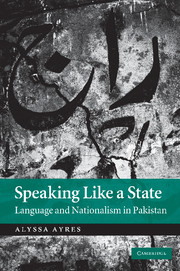Book contents
- Frontmatter
- Contents
- List of illustrations
- List of tables
- Acknowledgments
- Note on transliteration
- Introduction
- 1 Articulating a new nation
- 2 Urdu and the nation
- 3 The nation and its margins
- 4 The case of Punjab, part I: elite efforts
- 5 The case of Punjab, part II: popular culture
- 6 History and local absence
- 7 Bringing back the local past
- 8 Speaking like a state: language planning
- 9 Religion, nation, language
- 10 Conclusion
- Bibliography
- Index
3 - The nation and its margins
Published online by Cambridge University Press: 25 August 2009
- Frontmatter
- Contents
- List of illustrations
- List of tables
- Acknowledgments
- Note on transliteration
- Introduction
- 1 Articulating a new nation
- 2 Urdu and the nation
- 3 The nation and its margins
- 4 The case of Punjab, part I: elite efforts
- 5 The case of Punjab, part II: popular culture
- 6 History and local absence
- 7 Bringing back the local past
- 8 Speaking like a state: language planning
- 9 Religion, nation, language
- 10 Conclusion
- Bibliography
- Index
Summary
If East Pakistan, separated from its western wing by the vast space of India, had an attenuated relationship to the country's political center, that explanation fails for the regions in the territory that remains Pakistan today. As we saw in the previous chapter, much of the justification for the state's desire to remake the Bengali language revolved around the perception of its “un-Islamic” nature, whether due to its Sanskritic script or vocabulary, or prestige cultural traditions shared with Hindu Bengalis as well. By virtue of the fact that all the languages in the West Pakistan territory utilized an Arabic script, however, this charge could not be leveled. And yet several regions of Pakistan have felt similar cultural grievances. This chapter examines the problem of the nation and its margins in the territorial spaces where easy explanations of difference fail: Sindh, the Northwest Frontier, the Siraiki space of southern Punjab, and the sparsely populated large area of Balochistan. Sindhi, and the mohajir (“immigrant” or “settler”) conflict, are examined first; the Sindhi–mohajir opposition illustrates the process of ethnogenesis taking place through language. The more limited but important case of Siraiki, another “new” ethnolinguistic category is also examined. I recapitulate the example of Pashto as a language suspected of channeling irredentism along the Pakistan–Afghanistan border, and briefly consider the role of language and cultural politics in Balochistan's long-running nationalism.
- Type
- Chapter
- Information
- Speaking Like a StateLanguage and Nationalism in Pakistan, pp. 48 - 66Publisher: Cambridge University PressPrint publication year: 2009

